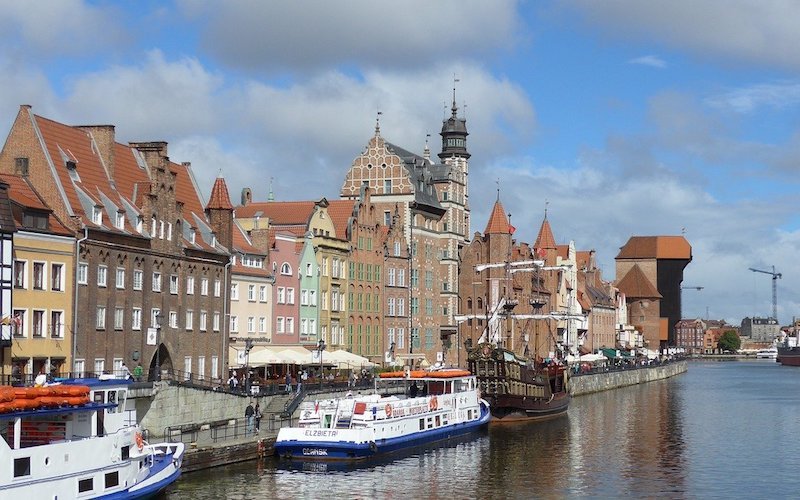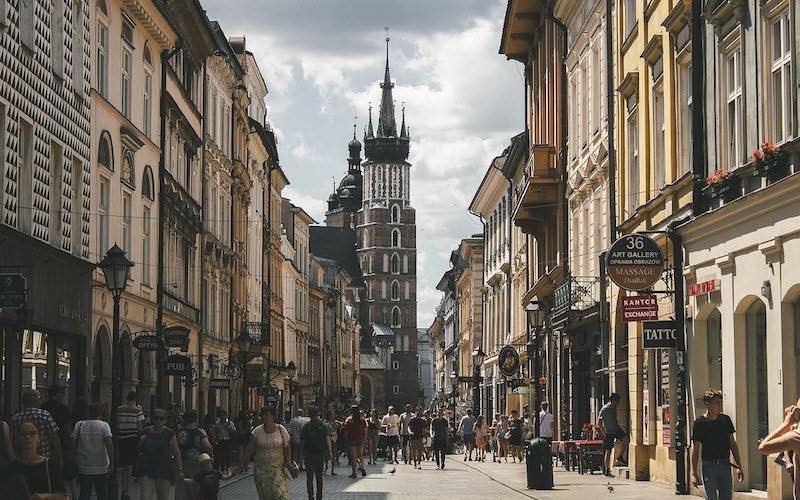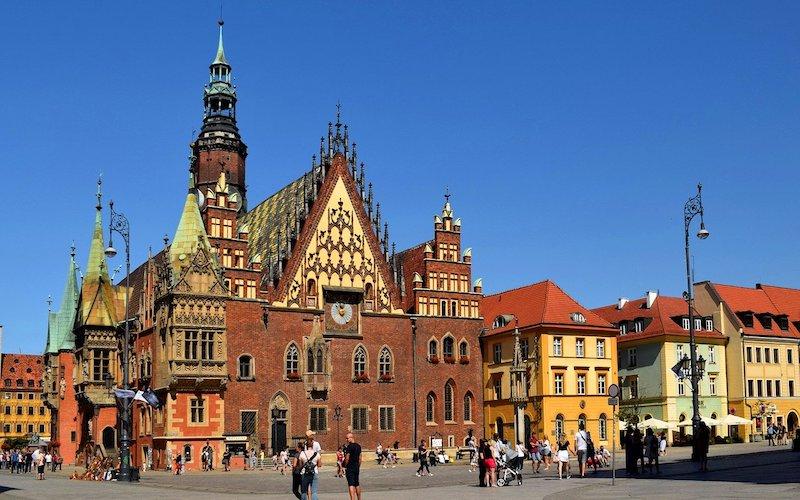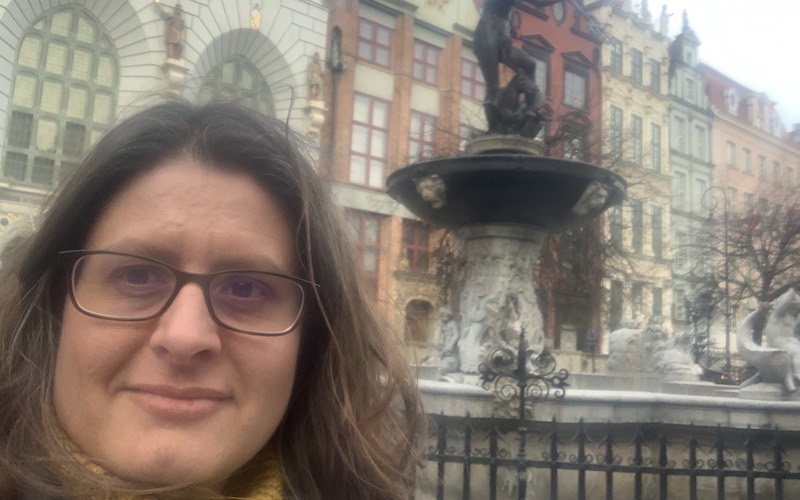Traveling solo as a woman can be a rewarding and enriching experience, and Poland is a great destination to consider for your next solo adventure. It’s one of my favourite countries to visit! From its vibrant cities and stunning natural landscapes, to its rich culture and history, Poland has a lot to offer the curious and independent traveler. In this blog post, we will explore some of the best places to visit in Poland for solo female travelers, and provide some useful tips and advice on how to make the most of your trip. Whether you are a seasoned solo traveler or just starting out, we hope this post will inspire you to pack your bags and embark on solo female travel in Poland.
Solo Female Travel in Poland – When to go
The best time to visit Poland depends on your preferences and what you want to do during your trip. In general, the warmest months are June, July, and August, when temperatures can reach up to 80 degrees Fahrenheit (27 degrees Celsius) in some parts of the country. These months are also the busiest, with many tourists flocking to Poland’s popular cities and attractions.
If you prefer milder weather and fewer crowds, you might want to consider visiting Poland in the spring or autumn, when temperatures are cooler and the landscapes are at their most beautiful. Winter in Poland can be cold, but it also offers the opportunity to experience the country’s festive traditions and enjoy its stunning snow-covered landscapes. Overall, the best time to visit Poland is a matter of personal preference, so consider what you want to do and see during your trip, and plan accordingly.
For me, I REALLY feel the cold! I went to Gdansk in February once and I really felt it was too cold for me. My preferred time to visit is the shoulder seasons of May and September – when the weather is still relatively mild but the crowds are less.
A Brief History of Poland
Poland is a country in Central Europe with a rich and complex history. It’s important to understand this if you are visiting Poland either with someone else or as a solo traveller.
The area that is now Poland has been inhabited for thousands of years, and has been ruled by a number of different civilizations and empires, including the Celts, the Slavs, the Germans, and the Mongols. In the 10th century, Poland emerged as a united kingdom and began to develop a distinct national culture and identity. In the centuries that followed, Poland experienced periods of growth and prosperity, as well as periods of conflict and foreign domination. In the late 18th century, Poland was partitioned by its neighbors and ceased to exist as an independent state for over a century. In 1918, Poland regained its independence, and has since become a democratic and prosperous country.
Poland played a significant role in World War II and was one of the countries most heavily affected by the conflict. In September 1939, Germany invaded Poland from the west, and the Soviet Union invaded from the east. Poland was quickly conquered and divided between the two powers, and its government and military were disbanded. Over the next six years, the country was occupied by Nazi Germany and the Soviet Union, and millions of Polish citizens were killed, imprisoned, or forced to flee. The Polish resistance movement fought against the occupation, but was ultimately unable to prevent the country’s devastation. After the war, Poland fell under Soviet control and was a part of the communist bloc until the fall of the Soviet Union in 1991. Today, Poland is a democratic and independent country, and the events of World War II continue to be remembered and honored.
How to get to Poland
There is a good selection of cheap flights from the UK to Poland with Jet2, EasyJet and Ryanair all offering routes….
- Newcastle to Kraków – Jet2
- Bristol to Krakow – Easyjet
- Manchester to Kraków – Easyjet
- Edinburgh to Kraków – Easyjet
- London Luton to Kraków – Easyjet
- Gatwick to Kraków – Easyjet
- London Stansted to Katowice – Ryanair
- Birmingham to Poznan – Ryanair
- Leeds to Poznań – Ryanair
- Liverpool to Poznań – Ryanair
- London Stansted to Poznań – Ryanair
Solo female travel in Poland – Is it safe?
Poland is generally considered a safe destination for solo female travelers. Like any other country, it is always important to take basic safety precautions, such as staying aware of your surroundings, avoiding poorly lit areas at night, and not carrying large amounts of cash or valuables. It is also advisable to research your destination before you travel and to familiarize yourself with local customs and laws.
However, overall, Poland is a welcoming and friendly country, and solo female travelers should not be deterred from visiting. In fact, many women travel solo in Poland without incident and have a wonderful time exploring the country’s vibrant cities, rich history, and stunning natural beauty.
Getting around Poland
I have travelled to Poland and travelled within Poland as a solo female traveller and have not had any problems. There is a good network of both trains and buses making solo female travel in Poland very easy and accessible.
Trains in Poland
The trains are very comfortable and I have found most train stations in the main tourist cities (Gdansk, Krakow, Warsaw) have people who speak English. Train is my preferred way to travel in Poland as their system is so easy to use and efficient. Be aware that you will usually be given a seat number and it is important to stick to that (unless you are offering up your seat for an elderly person which is polite in Poland). You can book trains in Poland on the website here or here. Alternatively, just rock up at the station – I have never really had a problem getting a same day ticket.
Buses in Poland
Flixbus operate in Poland and you can use them to get around Poland and to get to other European destinations including Munich and Prague. There are the Sinbad buses which I haven’t used personally, but I have heard them recommended by other travellers. You can also use the Podroznik buses for within Poland – book them here.
Travel Challenges in Poland
- Language barrier – Although many Polish people do speak English, you may face the language barrier travelling around the country, especially on local trains and buses.
- Smoking – Around a third of Polish people smoke and so this may be more than you are used to perhaps in UK or USA. The can be an annoyance, particularly if you have a health condition such as asthma.
- Pickpockets – You may still experience pickpockets in touristy areas such as the Old Towns and on trains. Keep your belongings close to you and secured, and don’t set your phone down on tables in cafes and restaurants (especially in touristy towns).
- Taxi Scams – Sometimes taxi drivers can try to overcharge you when they find out that you are a tourist. Using the UBER app eliminates this risk because you will know what you are paying for every journey (so make sure that you download the app here).
- Cold weather – In the winter the temperatures can drop below freezing. Make sure that you pack hat, scarf, gloves and warm jumpers.
- Challenges for LGBT (Lesbian, gay, bisexual, and transgender) travellers – Poland unfortunately has one of the worst records for LGBT rights in Europe. Article 18 of the Constitution limits the institution of marriage to opposite-sex couples and civil ceremonies are not recognised. Be aware of some homophobia.
- Avoid drinking alcohol on the streets – this is illegal.
Backpack or Suitcase for Poland?
I have travelled to Poland as a solo traveller with both a backpack and a suitcase in the past and both have worked well. I would advise that you go for a backpack for moving around to more than two or three cities, but a suitcase is OK for a single or dual destination trip provided you can book airport transfers.
What to pack for your Solo Trip to Poland
Because of the high amount of cheap flights to Europe with airlines such as Ryanair, you may choose to travel light which will mean packing hand luggage only.
- Money and passport – Make sure that you get some money changed to Polish Zloty ahead of your trip so that you have cash at the ready as soon as you arrive at the airport.
- Jumpers and a rain jacket – the Polish weather can be changeable especially in the winter months and so be prepared.
- Good walking boots – these are essential as there is a lot of walking in Poland whether you are doing walking tours of old towns or hiking in the Polish mountains.
- Gadgets and chargers – Remember to pack the chargers for your smart phone and laptop.
- Camera and spare batteries – You will want to take a lot of photos so make sure that you take your camera as well as backup (smartphone or point and shoot camera)!
- European plug adapter – the sockets in Poland are the ones with two prongs (types C and E).
- Versatile Clothing – Jeans, T-Shirts, jumpers and cardigans are perfect. Girls you may want to bring a dress or two if you want to go out to experience some of the Polish nightlife.
- Beanie hat and fingerless gloves – As it can get cold in Poland especially in the winter months, a beanie and fingerless gloves are great items to pack. The fingerless gloves will keep your hands warm whilst still allowing you tonged money and tickets out of your purse.
- Lonely Planet Poland – Although you can find most of what you need online these days, I love to have a hard copy of the Lonely Planet to read when I travel.
Reasons to travel alone to Poland
- There are a great deal of castles, Churches and old town buildings to be explored – as a solo traveller you will be able to set your own schedule.
- Poland has a deep and interesting WW2 history. If you are moved to visit some of the memorials and museums (Gdansk WW2 museum and Auschwitz) these are very emotionally moving places and may be better visited solo. This element of tourism in Poland may not be one that you want to share.
- The locals are friendly and will make you feel welcome – most speak English.
- Poland is a good place for an extended trip for say two to three weeks. You can cover a lot of ground, so why wait for people to join you? Just go ahead and book your solo trip.
- It’s a good budget destination – you can see a lot with €50-60 a day.
- There are a great deal of lively hostels – I love staying in youth hostels and meeting people from all around the world. As a solo traveller you are more likely to meet other solo travellers.
- You can jump on the walking tours and e-scooter tours – this is a great way to get a local guide and is excellent value. Some of the walking tours are ‘free tours’ where you pay what you feel it is worth or what you can afford.
Solo Female Travel in Poland – Where to go
I totally love exploring the Polish cities, especially those with great Old Towns like Krakow and Gdansk. You can read more about the best cities in Poland here.
Warsaw
Warsaw is the capital and largest city of Poland. Located in the eastern part of the country, Warsaw is a modern and vibrant city with a rich history and culture. The city was almost completely destroyed during World War II, but it has been carefully rebuilt and now boasts a mix of modern and historic architecture.
Some of the top attractions in Warsaw include the Old Town, which features beautiful restored buildings and cobbled streets, the Royal Castle, which is a UNESCO World Heritage Site, and the Warsaw Uprising Museum, which is dedicated to the city’s resistance during World War II. Whether you are interested in history, art, or just soaking up the local atmosphere, Warsaw has something to offer every visitor.
Gdansk
Gdansk is a city in northern Poland, located on the Baltic Sea coast. It is a major port city and an important cultural and economic center. Gdansk is known for its beautiful architecture, rich history, and vibrant culture. The city’s Old Town is a UNESCO World Heritage Site and features a number of historic landmarks and attractions, including the beautiful Gothic St. Mary’s Church and the picturesque Long Market.
Gdansk is home to the largest WW2 museum in the world – it is so big that they had to build it underground. You will need to spend at least 3-5 hours exploring this museum and it is well worth a full day to be honest. I actually know a fellow RE teacher who actually spent 2 full days in that museum! Check out the museum website here. You can also read about the best museums of Gdansk here.
When you are in Gdansk you might decide to explore the ‘tri-city’ area – this means the three cities of Gdansk, Gdinya and Sopot, located on the Baltic Sea coast. Gdansk is the largest and most famous of the three cities, known for its beautiful architecture, rich history, and vibrant culture. Gdynia, located just north of Gdansk, is a modern and thriving city with a bustling harbor and a vibrant arts scene. Sopot, located just south of Gdansk, is a popular resort town known for its sandy beaches, historic pier, and lively nightlife. Together, these three cities make up the Tricity area, which is a popular destination for tourists and offers a wide range of activities and attractions to explore. They are all interlinked by a frequent and easy to use train service.

If you are looking for a good day trip from Gdansk I highly recommend visiting Malbork Castle. It’s a very doable day trip by train. This 13th Century castle and fortress that was originally used by the Teutonic Knights.
Kraków
Kraków is the second-largest city in Poland and one of the country’s most popular tourist destinations. Located in the southern part of the country, Kraków is known for its rich history, vibrant culture, and beautiful architecture. The city is home to a number of UNESCO World Heritage Sites, including the historic center, which features the largest medieval market square in Europe and the beautiful Wawel Castle.

It is also possible to visit Auschwitz from Krakow, which although not a fun day out, it is important for understanding Polish history. You can read more about that on my blog about Dark Tourism destinations.
Also, if you are interested in WW2 movies, Krakow was used as a filming destination for ‘The Pianist.’ You can also visit Oscar Schindlers factory which was featured in the movie ‘Schindler’s List’.
Wrocław
Wrocław is a city in southwestern Poland and the largest city in the country’s Silesia region. Located on the banks of the River Oder, Wrocław has a long and rich history, and is known for its beautiful architecture, vibrant culture, and thriving arts scene. The city is home to a number of historic landmarks and attractions, including the Gothic Wrocław Town Hall, the impressive Wrocław Cathedral, and the Tumski Bridge. It is one of the most beautiful old towns in Poland. Tumski bridge is said to be the most romantic spot in the city.

Poznań
Poznan is a city in western Poland, located on the banks of the River Warta. It is the fifth-largest city in the country and an important cultural and economic centre. The city’s Old Town is a UNESCO World Heritage Site and features a number of historic landmarks and attractions, including the Gothic Poznan Cathedral and the colourful Town Hall. The Poznan ‘goats’ come out of the tower of the town hall at noon every day which is a nice thing to see!
I found Poznan to be a very clean and friendly city – easy to navigate with a vibrant food scene. There is plenty to see and do in Poznan including exploring the history of Cathedral island (which dates back to the 10th Century and is seen as the birthplace of Poland and the start of Polish Catholicism).
The city is also home to an abundance of European street art around the central area, Srodka (to the East of Cathedral Island) and also in the area near to the zoo.
Lodz
Lodz is a city in central Poland and the third-largest city in the country. The city was once an important center of the textile and film industries, and its historic architecture reflects this industrial heritage.
During World War II, Lodz was occupied by Nazi Germany and was the site of several war crimes and atrocities. The city’s large Jewish population was forcibly relocated to the Lodz Ghetto, where they were subjected to harsh conditions and many were killed. The ghetto was also used as a labor camp, where prisoners were forced to work in factories and other facilities. In August 1944, the remaining residents of the ghetto were deported to Auschwitz-Birkenau, where most were killed upon arrival. After the war, Lodz was annexed by Poland and was rebuilt.
Today, Lublin is a vibrant and lively city with a rich cultural heritage. It is home to a number of universities and colleges, and is a popular destination for tourists interested in history and the arts. The city is known for its beautiful architecture, including the Gothic castle and several medieval churches.
Lublin
Lublin is a city in eastern Poland, located on the border with Ukraine. It is the capital of the Lublin Voivodeship (province), and is the ninth largest city in Poland. The city has a population of about 350,000 people.
Lublin has a long and rich history. It was first mentioned in historical records in the 10th century and was an important center of trade and culture in the region. In the Middle Ages, Lublin was an important center of Jewish culture and learning, and it was home to a number of important synagogues and yeshivas. During the Second World War, the city was occupied by Nazi forces and suffered greatly, with many of its residents killed in concentration camps. After the war, Lublin was a major center of industry and education in communist Poland.
Today, Lublin is a vibrant and lively city with a rich cultural heritage. It is home to a number of universities and colleges, and is a popular destination for tourists interested in history and the arts. The city is known for its beautiful architecture, including the Gothic castle and several medieval churches. It is also home to a number of museums and galleries, as well as a thriving theater and music scene.
Katowice
Katowice is a city in southern Poland and the capital of the Silesia region. Located in the heart of the country’s industrial and mining region, Katowice is known for being a popular student city in Poland. The city was once an important centre of the coal and steel industry, and its historic architecture reflects this industrial heritage. The city is also a popular destination for sports fans, with a number of professional teams and major sports events taking place throughout the year.
Top tips for Solo Female Travel in Poland
- The currency in Poland is still the zloty. It is a good idea to get some money changed before you go and have some low denominations and coins readily available if possible,
- Your UK Visa Credit or Debit Card is likely to work in Poland for both drawing out cash and using for transactions in both bars and restaurants so take it along with you.
- Download the UBER app for Taxis which has worked well for me in the majority of Polish cities.
- 112 is the general emergency number (equivalent to our 999) that connects to Police, Fire and Ambulance, so save this in your phone.
- Eat Pierogi! Polish dumplings (Pierogi) are absolutely amazing and great value, so please make sure that you try them.
- Drink Vodka! Polish Vodka is amazing and the bar staff will recommend the best for you. I often like to bring back a bottle of Cherry Soplika or Wyborowa.
- Do the electric scooter tours! Many cities including Gdansk, Krakow and Warsaw) have tours on electric scooter and they are great because the streets are flat enough for it and you cover much more ground than on the walking tours.
Further reading on Solo Female Travel in Poland
If you enjoyed this article on Solo Female Travel in Poland then you might also like to read:

